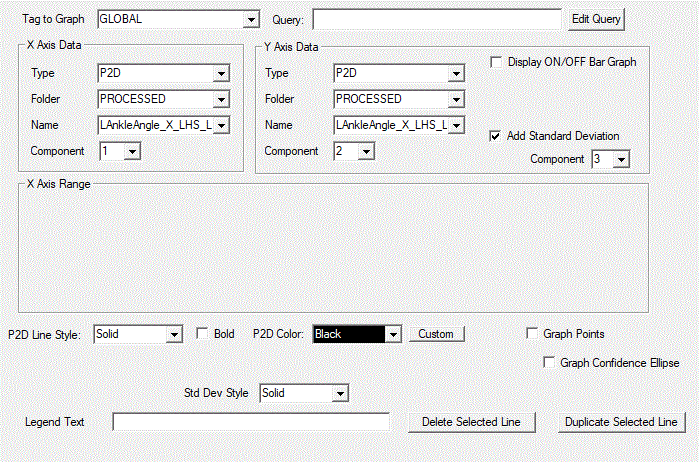Table of Contents
P2D Format
The P2D file format was part of the original MOVE3D software written, which formed the basis of Visual3D. This file format can still be imported by Visual3D to provide backwards compatibility with legacy data at the NIH, to summarize a normal database, and for creating “odd-ball” graphics overlaid on report graphs.
P2D Signals
P2D files are opened in Visual3D and stored in the GLOBAL folder of the Visual3D workspace as P2D signals. These signals retain the same format as the P2D files, and we treat the terms “P2D file” and “P2D signal” synonymously.
The original P2D files contains the mean and standard deviation components of a signal. In keeping with this tradition, the Global_Normalized_Signal_Mean command produces P2D signals as well.
Format
Any laboratory can create a series of P2D files that represent their normative data. If the user opens all P2D files at once and saves a CMZ file, then the CMZ file will contain all of the P2D data signals in a single file.
The P2D file is a text file that contains a simple header and data section. The header (first) record of the P2D file contains three integers separated by a space. The first integer is the number of data entries (or rows), the second integer is the number of ordinate columns and the third integer is always zero. For example:
15 2 0
The columns of the output P2D files are separated by blank spaces. Each column is a component in the P2D signal and each column contains the same number of rows. For example, two frames of data are represented by two rows:
0 1 1 1.1
Taken together, we get the complete P2D file format:
15 2 0 1 0 2 15.3774 3 10.6582 4 6.2569 5 2.9658 6 1.0071 7 0.1427 8 -0.0545 9 0.0276 10 0.1536 11 0.2424 12 0.2803 13 0.2677 14 0.2041 15 0.1907
Working with P2D Data
The File → Open menu option allows the user to open P2D data: a signal is created in Visual3D with the same name as the P2D file name on disk. When a P2D file is opened in Visual3D it is stored in the GLOBAL Workspace.
For a variety of historical and technical reasons, P2D data does not appear in the data tree. The only way to access P2D data is when you are generating a report graph by selecting the data type to be P2D. P2D data must be displayed against itself and a typical graph would have component 1 on the x-axis, component 2 on the y axis, and component 3 as the standard deviation.
Example: Mean and Standard Deviation for One Signal
A common use of the P2D format is for storing the mean and standard deviation data for one signal (e.g. from normative data). In the following example a P2D file containing time-normalized data (51 points) for the mean and standard deviation will appear as:
51 2 0 1.000000 -0.171476 0.064203 2.000000 -0.193810 0.052127 3.000000 -0.194081 0.107100 4.000000 -0.150445 0.121488 5.000000 -0.059907 0.087786 6.000000 0.042586 0.043269 7.000000 0.118689 0.035538 8.000000 0.156265 0.050328 9.000000 0.172037 0.062839 10.000000 0.183095 0.067463 11.000000 0.194891 0.070898 12.000000 0.204698 0.078152 13.000000 0.211091 0.088810 14.000000 0.215793 0.098449 15.000000 0.220938 0.103864 16.000000 0.225731 0.104650 17.000000 0.228312 0.102229 18.000000 0.228412 0.098830 19.000000 0.227623 0.095728 20.000000 0.227414 0.093014 21.000000 0.227485 0.089656 22.000000 0.226159 0.085224 23.000000 0.221815 0.080099 24.000000 0.215041 0.075135 25.000000 0.207752 0.070403 26.000000 0.201338 0.066043 27.000000 0.195480 0.061912 28.000000 0.189448 0.057273 29.000000 0.183203 0.051364 30.000000 0.176926 0.044302 31.000000 0.170491 0.037066 32.000000 0.163738 0.030801 33.000000 0.156836 0.026320 34.000000 0.150075 0.023576 35.000000 0.143514 0.022056 36.000000 0.137175 0.021138 37.000000 0.130963 0.020152 38.000000 0.124659 0.018674 39.000000 0.117935 0.016824 40.000000 0.110651 0.015405 41.000000 0.102797 0.015020 42.000000 0.094458 0.015891 43.000000 0.085670 0.017849 44.000000 0.076587 0.020574 45.000000 0.067596 0.023515 46.000000 0.059138 0.026223 47.000000 0.051278 0.028302 48.000000 0.043641 0.029549 49.000000 0.035876 0.029884 50.000000 0.028065 0.029869 51.000000 0.020488 0.030334

